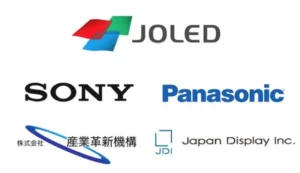A joint organic light-emitting diode (OLED) display venture between Panasonic and Sony, JOLED announced that it has filed for court protection, with outstanding debts amounting to ¥33.7 billion ($260 million). The company plans to withdraw from the display manufacturing industry and shutter its factories in Ishikawa and Chiba prefectures.
Approximately 280 of the company’s 380 employees will be laid off, as the beleaguered venture aims to refocus its efforts on development. JOLED has faced declining demand for OLEDs and mounting competition from rivals, leading to delays and cost overruns in achieving stable production.
Japan Display, a former shareholder in JOLED, will take over the company’s display technology R&D. The Japanese state-backed fund , Innovation Network Corporation of Japan (INCJ), which has a 56.8% stake in JOLED, investing a staggering total of ¥140 billion ($1.07 billion) in the company, is taking the biggest hit of all. The company struggled with mass production and was unable to compete with more affordable rival products, ultimately leading to the need for court protection. Japanese auto parts manufacturer, Denso, owns 16.1% of the company because, at one point, automotive displays were going to be where the business was at for JOLED. If you take a look at the milestones of the company over the years, you can see a pattern of partnerships and attempts to find a market. They zig-zag through different application areas, but nothing seems to stick.
The JOLED Milestones
In December 2017, JOLED announced that it had started commercial shipment of its first OLED panels, manufactured using its proprietary inkjet printing method. This technology enabled the company to produce OLED displays more efficiently, with less material wastage, and at a lower cost compared to traditional manufacturing methods.
For a brief period, the company seemed to be making some strides. In October 2020, JOLED announced that it had started mass production of printed OLED displays at its Chiba plant in Japan. This was a significant milestone for the company, as it marked the first time that printed OLED displays had been mass-produced. In November 2020, there was a collaboration with Lenovo to develop and manufacture OLED displays for use in Lenovo’s upcoming laptops at that time. This partnership was expected to help JOLED expand its customer base and increase demand for its OLED displays. In December 2020, there was a partnership with LandSkip to jointly develop a digital airplane window. In January 2021, JOLED announced that it had successfully developed a 55-inch 4K OLED display using inkjet printing technology. This was a significant achievement for the company, as it demonstrated the scalability of its printing process to larger display sizes. In February 2021, there was another partnership, this time with Eyesafe, a company that develops and certifies displays that meet certain standards for blue light emissions. The partnership was aimed at developing OLED displays that meet Eyesafe’s standards for blue light emission.
By August 2022, though, Display Daily was writing about a possible bankruptcy. And here it is, today. During all those PR milestones, JOLED was barely able to make it out of the starting gate. There was Oledio, for medical imaging. There was getting sued by Samsung. Then, there was the collaboration with LG. Just a zig -zag of ideas, products, and relationships. At the end of the day, seems like most of the investment was in trying to build up the company’s profile, puffed up, and not enough to make it a competitive manufacturer.

